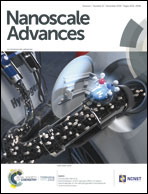High-performance laminated luminescent solar concentrators based on colloidal carbon quantum dots
Abstract
Luminescent solar concentrators (LSCs) are light-weight, semitransparent and large-area sunlight collectors for solar-to-electricity conversion. To date, carbon quantum dots (C-QDs) have attracted a lot of attention due to their size/shape/composition tunable optical properties, high quantum yield, excellent photostability, lower toxicity and simple synthetic methods using earth-abundant and low-cost precursors. However, due to the overlap between their absorption and emission spectra, it is still challenging to fabricate high-efficiency LSCs based on C-dots. In this work, we used C-QDs to fabricate semi-transparent large-area laminated LSCs (10 × 10 cm2). C-QDs have the absorption spectrum ranging from 300 to 550 nm with a Stokes shift of 0.6 eV. By optimizing the concentration of C-QDs, the laminated LSC exhibits a highest ηopt of 1.6%, which is 1.6 times higher than that of a single-layer LSC (100 mW cm−2). In addition, the laminated LSC exhibits a power conversion efficiency of 0.7% under natural sunlight illumination (62 mW cm−2) with excellent photostability. These findings suggest that laminated structured LSCs could be used for efficient solar energy harvesting compared to single layer or tandem structured LSCs based on colloidal C-QDs.

- This article is part of the themed collection: Quantum and carbon dots


 Please wait while we load your content...
Please wait while we load your content...